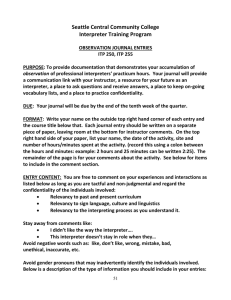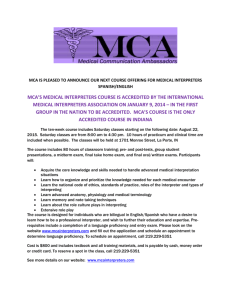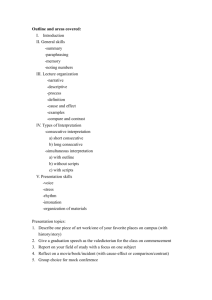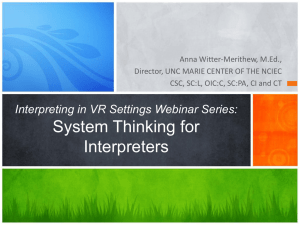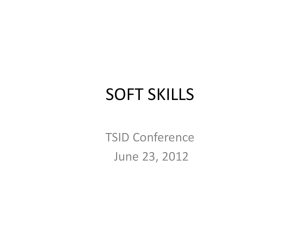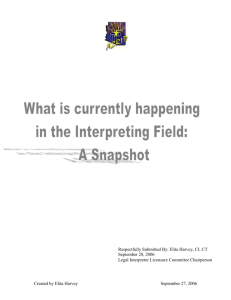(MS PPT) TRIN 3102 Week 1
advertisement
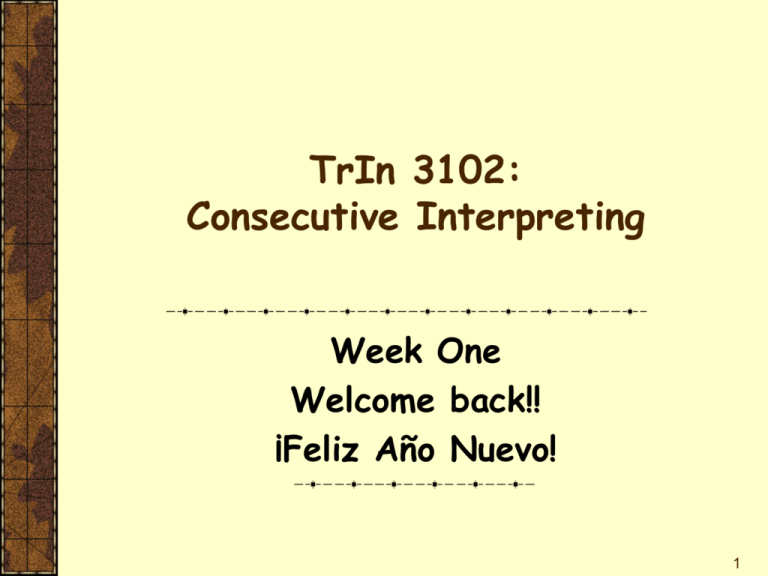
TrIn 3102: Consecutive Interpreting Week One Welcome back!! ¡Feliz Año Nuevo! 1 Class agenda for Week One Lecture Course goals, format and requirements Review steps of interpreting model Process for change model Steps for a skill development plan Reading assignment for Week 2 Lab General introduction of lab structure and purpose Skill practice: prediction, identify main idea, short term memory practice with chunking, visualizing and focus on key words 2 Review of Interpreting Model A.The Source/Target Message boxes include the components of message meaning in the handout “How do we construct meaning (the message)?” B.Receptive/Expressive Channels These areas refer to the channels of transmission from the speaker (receptive) or expression from the interpreter (expressive). The speaker may be speaking English but may be also pointing/gesturing/posturing through the visual channel. That is why it is important to hear and see the speaker when possible. 3 Analysis and Composition Factors 1.Process skills a. ANALYSIS refers to the interpreter’s ability to quickly and accurately derive meaning from the source message; it includes attending (blocking distraction), analysis and synthesis, ability to access short-term memory, ability to access long-term memory for knowledge, and retaining form when appropriate (e.g. proper names). 4 Composition b. COMPOSITION refers to the interpreter’s ability to quickly and accurately construct language forms from the Message; it includes retrieval of linguistic and cultural knowledge, ability to access short-term memory, ability to access long-term memory for knowledge, as well as planning the production of the target message. 5 Process Management This element of the process is responsible for “supervisory” functions: Allotting and modifying process (lag) time to allow for analysis/composition Chunking message units into manageable sections Monitoring the sequence of operations Making decisions about obtaining clarification/ restatement from the speaker in analysis stage Making decisions about repairing a portion of the target message in the composition stage 6 Competence in Source/Target Language and Culture Language refers to both knowledge about grammatical rules, vocabulary, discourse styles, and phonological constraints as well as the ability to perform functions appropriate to context. Culture refers to both knowledge about norms, values, rules, traditions and beliefs held by members of the culture as well as the ability to behave in culturally appropriate ways. 7 Knowledge This term refers to the stored experiences in long-term memory and the learning which the interpreter has accumulated in all sensory and intellectual contexts. For any given assignment, it refers specifically to knowledge relevant to the message being interpreted. 8 Preparation This item refers to any means the interpreter has used to prepare for the task at hand. Physical dimensions: sleep, exercise, nourishment Emotional/psychological dimensions: confidence, stress management Content-related dimensions: meeting with speaker, researching topic Contextual dimensions: researching participants, environment Task-related dimensions: meet with team members, coordinator 9 Environment Any and all conditions which exist at the time of the interpretation External environmental include: Physical factors (lighting, temperature, time of day, noise) Psychological factors (stress, emotional displays) Cultural factors (conflicting behaviors and/or expectations) 10 Internal environment includes: Physical factors such as fatigue or illness Psychological factors: perceived evaluation, bonding with speaker Emotional state of the interpreter as s/he reacts to the speaker,topic, or audience 11 Filter(s) The term refers to the interpreter’s own “baggage” which may filter in, filter out, or distort any aspect of the message as well as process factors. Interpreters have their own biases, beliefs, personalities and habits which do affect how they perceive people, situations and meaning. The ability to recognize when filters may be hindering performance and accessing the resources necessary to intervene may be crucial to the outcome. 12 Message Refers to the meaning of the speaker’s message, represented through non-linguistic means, which has been extracted by the interpreter during the analysis phase of the process. 13 Process for Change Model Often people resist change because they are uncertain as to the results they will get. New behavior can take some time to be internalized. Once you are aware of how the change process works and have a better understanding of its dynamics, you will be able to approach change more positively. The following model consists of a 4-step process for integrating and internalizing a new behavior or skill so that the behavior or skill eventually becomes part o your behavior pattern for improved effectiveness. 14 Change Process Model Step 1: Nonawareness Unconscious of one’s behavior that results in ineffectiveness Step 3: Internalizing Consciously putting into practice the new behavior or skill Step 2: Awareness Conscious of one’s behavior that results in ineffectiveness Step 4: Integrated Unconsciously applying the new behavior or skill 15 Internal Experience that Takes Place when Integrating a New Skill or Behavior Resistance: Natural tendency to stay with what is familiar. Being Unsure: When we start to apply new skills and behaviors, we may feel phony. Assimilation: Feeling less phony and becoming comfortable with the new behavior and new skill. Transference: Applying behavior or skills learned in one setting over to another setting or situation. Integration: Automatically and unconsciously reproducing the new behavior or skill. 16 Beyond the Classroom: Establishing Personal Structure What can we do after we graduate from our Interpreter Training Programs and workshops and while we wait for the next? Bill Isham, in his article “Beyond the Classroom: Self-Directed Growth for Interpreters”, describes 5 major categories of self-directed growth: 17 1. Goal Setting Two reasons for setting personal goals 1. Identify, define and improve weaknesses A. Personal identification of problem areas B. Consumer feedback 2. Prioritize weaknesses to avoid frustration A. Concentrate on improving one or two weaknesses and file the rest for later B. Examples: production errors, insufficient technical vocabulary/terminology, too little lag time, appropriate affect, register and style 18 2. Time Frames Language-related skills have to become second nature as much as possible. REPETION and PRACTICE are essential! Set an arbitrary amount of time in which to tackle these goals. Through trial and error, one quickly learns what are realistic time frames for any given goal. But DO NOT change goals the minute you notice improvement. Adjust your time frame as you notice a habit is forming and you don’t have to concentrate as much. 19 Time Frames continued . . . Improvement in language skills is necessarily slow and gradual, and we can only notice lasting change after longer periods of time. 20 3. Written Records It is helpful to record and react to your daily experiences. This journal can be part diary where new experiences can be jotted down, such as unusual ethical situations you have encountered. New lexical items from either language are also listed, along with synonyms and a few equivalents in the other language. Terms difficult to translate can be noted . . . leaving enough space to fill in appropriate interpretations later. Carry your journal with you at all times. Leaving it at home encourages avoidance. 21 4. Feedback Ask consumers appropriate questions: Was my voice loud enough? Ask fellow interpreters for input and encouragement Observe another interpreter and compare to oneself. Look for yourself (weaknesses or strong points) in other interpreters. 22 5. Guidance Mentorship: Develop a relationship with someone you respect and trust implicitly, someone whose help you need or want. The idea of a mentor is particularly appropriate for our field. Interpreting requires a lifelong commitment to learning and more individualized and on-going instruction are a plus. Meeting once or twice a month to go over journal entries and discuss concerns can be a rewarding experience for both parties involved. 23 Steps for a Skill Development Plan In small groups, brainstorm steps to establish an individual skill development plan: Stage 1: Identify the skills a professional interpreter is expected to have. Stage 2: Assess the level of your individual skills. Stage 3: Establish realistic goals and timeline to improve or refine those skills. How will you know you have accomplished those goals? Stage 4: List your specific plans/activities to develop your professional skills. Stage 5: Develop a plan to monitor your progress. Bring your typed plan for the instructor during the next class. 24 Lab Structure and Purpose Small group work and individual work Practice of dialogues and sight translations Review of individual work or partner’s work for feedback Feedback from the instructor Role modeling of techniques and skills Discussion and practice of difficult situations Introduction of vocabulary for specific settings Please bring your video cassette tape, tape recorder and audiotapes for every class. Make sure your recorder batteries are charged. 25 Week One: Skill practice and review in English or non-English language 1. Apply prediction to interpreting work 2. Practice comprehension with focus on main ideas 3. Practice increasing short-term memory by using various techniques such as chunking, visualizing and focusing on key words or ideas 26 Lab Exercise 1.1: Prediction The context of a text will be described. Brainstorm with your partner all the possible topics that might come up. Make a short list of possible terms/vocabulary with your partner. As the text is read aloud, check off the topics and vocabulary that have been predicted. Why is using prior knowledge important in interpreting? 27 Lab Exercise 1.2: Intra-lingual Listening activity Groups of 3-4 students (Students A, B, C, D). Each student will write a 1-2 minute story on paper. Use dates, numbers, names, and action verbs. Student C leaves the room and Student A tells Student B a 1-2 minute story. Student C returns to the group and Student B tells student C the story. Student A listens for accuracy. Repeat the activity with each student assuming each role. The fourth student can take notes while Student A tells the story and can listen for the accuracy of the story when it is retold. 28 Lab Exercise 1.3: Paraphrasing Note: Paraphrasing is NOT interpreting; it is restating the meaning of the message by using different words or phrases. Pair activity (Students A and B) All students listen to the lab instructor read a text aloud. The instructor will designate either Student A or B to paraphrase the text for the partner. The partner should listen to the paraphrasing for accuracy in terms of content. 29 Lab Exercise 1.4: Main Idea A short text will be read aloud. Write down the main idea in 10 words or less. Focus on the main purpose of the text. Students will compare their responses with a partner. Identify differences or difficulties. 30 Lab Exercise 1.5: STM-Visualization As you listen to the text, sketch pictures/symbols to assist in remembering the information. With a partner, use your sketched symbols to retell the text to your partner. Compare notes and assess how you were visualizing the information. 31 Lab Exercise 1.6: STM-Chunking A text will be read aloud with a pause after each sentence. Focus on your chunking skills (<7 units) to improve your memory. Repeat the sentence for your partner. 32 Assignment for Jan. 25, 2006 Please re-read the article, Consecutive Interpreting (González) and Steps to Consecutive Interpreting (Bowen and Bowen) in your reading text. Write down 1 thought question per article Type a one-page double spaced analysis of your present skills and three (3) professional goals with your plan to achieve those goals (see slide #24). Have a great week! 33
